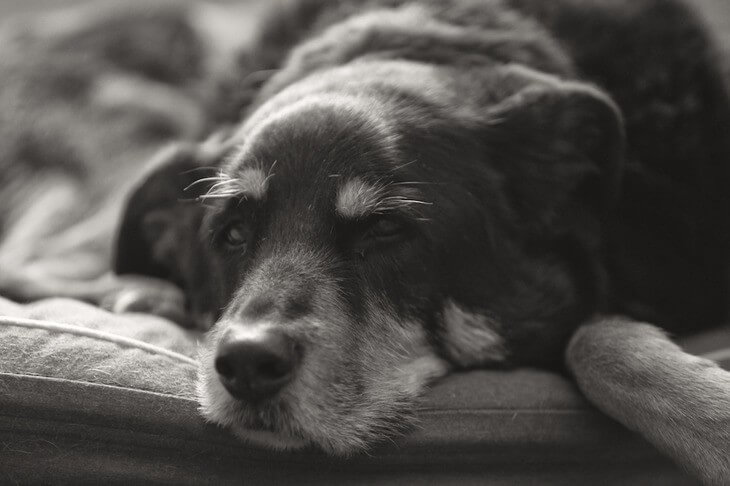Your young dog suddenly becomes paralyzed and can hardly move? He may have painful panosteitis. Learn more about bone inflammation, which particularly affects large breed adolescent dogs.
What is Panosteitis or Periosteum Inflammation?
The end of the word “-itis” already indicates: Panosteitis is an inflammation that in this case affects the bones. It can occur on any bone, but it is often concentrated in the long tubular bones on the dog’s legs.
Panosteitis occurs primarily in young, large, or medium-sized breed dogs with rapid growth from five to eight months of age.
The disease rarely occurs later. However, there are individual cases of five-year-old animals who develop panosteitis for the first time.
Canine Panosteitis: Symptoms

The inflammation occurs in bursts and can affect one leg or several. Subsequent symptoms such as apathy can be traced back to severe pain.
- Limping and lameness
- Reluctance to move
- Pain when palpating the legs
- Pain when stepping on
- Apathy
- Unwillingness to eat and weight loss
- Nervousness or aggression
- light fever
Individual legs or all four can be affected. If the dog has pain in all legs, it can cause him to lie down on his back and no longer want to walk. Because every load on the legs is accompanied by pain.
Mild forms of panosteitis are possible. For example, with active and active dogs who suddenly have less urge to be active. In panosteitis, the pain occurs for no apparent reason and increases within a few days. The acute phase lasts around three weeks. Then there may be further attacks on the same or on different legs.
Canine Panosteitis: When to Go to the Vet for an X-ray?
If you notice the symptoms mentioned in your four-legged friend, you should make an appointment with a veterinarian after one day at the latest. Of course, there may be other causes behind the symptoms. But apathy or gait disorders always require the advice of an expert.
If panosteitis is suspected by age, race, and palpation, the vet will take an X-ray to help confirm the diagnosis. The inflammation in the bone tissue can then be easily recognized in different forms, depending on the phase of the disease. Since panosteitis can coexist with hip or elbow dysplasia, the veterinarian can recommend further clarification.
Causes of Panosteitis
The causes of panosteitis are not clearly understood. German shepherds in particular, as well as other large or very large breeds, suffer from episodes of inflammation. Experts, therefore, assume two causes: genetic factors and poor nutrition. Because if large breed young dogs grow too fast due to too much energy and calcium in their diet, this can have a negative effect on skeletal growth.
Panosteitis: Treatment and Medication
The good news first:
In most cases, panosteitis heals on its own within a few months without leaving any secondary symptoms.
Since the inflammation is very painful, symptomatic therapy is urgently recommended. The vet prescribes pain relievers and anti-inflammatory drugs for this. In addition, pet owners should adjust their diet in consultation with the veterinarian. To do this, the vet will compare the dog’s growth with common growth curves. If necessary, reduce calories and calcium.
Dogs suffering from acute attacks of panosteitis should exercise gently. Avoid stairs, hopping and long walks, as well as games with quick stops. Exercise affected dogs with short exercise units and mental work in the form of intelligence and sniffing games.
Proper Nutrition: What Food for Panosteitis?
Although the causes of panosteitis are unclear, it can be assumed to be related to nutritional deficiencies. This is not the only reason why it is important to pay attention to a suitable diet for dogs of large breeds or mixed breeds with heavy parents. XXL dogs like Great Danes take a long time, up to two years of age, to become physically fully grown. It is important to give your four-legged friends this time. This means that the dogs shouldn’t put on baby fat, but rather stay in shape.
Too much food can unfavorably accelerate the growth process – the dog grows faster than its bones.
This can lead to irreparable damage to the joints. Owners of puppies and young dogs of large breeds should therefore keep a close eye on the weight of their four-legged friend. Obtain a weight table for dogs of the appropriate breed or have the veterinarian check the weight regularly.
If your four-legged friend gains weight too quickly, reduce the daily rations. Replace snacks and delicacies with dry food that your four-legged friend works out for during training. Play it safe with large breed puppy or young dog food. Its energy and nutrient content is tailored to the growth of large dogs.

